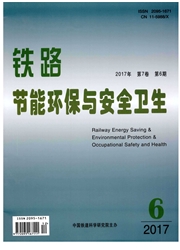

 中文摘要:
中文摘要:
为了解我国城市轨道交通站台噪声影响现状,本文给出了3座典型高架车站、8座典型地下车站站台噪声现场实际测量结果。结果显示,高架站台列车进站噪声L_(Aeq)平均值为78d B(A),出站噪声L_(Aeq)平均值为79d B(A)。地下车站列车进站噪声L_(Aeq)平均值为69~78d B(A),出站噪声L_(Aeq)平均值为68~79d B(A),均可满足《城市轨道交通车站站台声学要求和测量方法》(GB14227—2006)标准要求。其中列车进、出站运行噪声在全封闭屏蔽门站台较无屏蔽门站台噪声L_(Aeq)低7d B左右,半封闭屏蔽门较无屏蔽门站台噪声L_(Aeq)低4d B左右。站台列车进站出站运行噪声呈宽频带特征。站台站务人员每天工作8h所接受的噪声影响,白班噪声暴露值L_(Aeq)为65~73d B(A),夜班噪声暴露值L_(Aeq)为64~72d B(A),也可满足《工作场所物理因素测量第8部分:噪声》(GBZ/T189.8—2007)标准限值要求。
 英文摘要:
英文摘要:
In order to study the noise level and characteristics of platform of the city metro, three elevated stations and eight underground platforms were selected and measured. The result shows that the LAeq value is 78 and 79dB( A)when train is coming and going for elevated station. LAeq is 69 - 78 and 68 - 79dB(A) when train is coming and going for underground station. The results shows that the effective acoustical reduction LAeq is about 7dB(A) between with and no security door, about LAoq is about 4dB(A) between with no complete sealed and no security door. The spectrum analysis shows that platform noise has the feature of wide-bend noise . The noise exposure LAoq for platform staffs are 65 -73dB (A) in day shift and 64 - 72dB (A) in night shift.
 同期刊论文项目
同期刊论文项目
 同项目期刊论文
同项目期刊论文
 期刊信息
期刊信息
